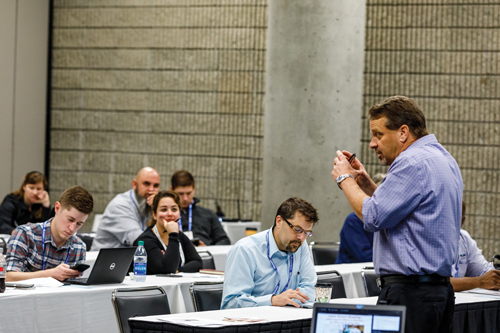Applications of Alternative Methods for Hazardous Energy Control
OSHA introduced the regulation known as 1910.147 for the control of hazardous energy in the late 1980s, based on the original ANSI/ASSE document known as Z244.1. With the release of an updated Z244.1 in 2016, language includes the current technology of modern-day safety systems as well as how to utilize this technology for enhanced machine efficiency. The presentation will review the updated language in Z244.1, safety-related parts of control systems and provide examples on how it can apply to various scenarios encountered in the production environment.
Ted Sberna, White Horse Safety Consultants
2–3:30 p.m.
Application of Real-Time Visual Monitoring Tool in Stamping
The first-time quality of stampings with reduced scrap rates is a primary goal of metal stampers. The real-time visual monitoring tool was recently introduced to monitor the stamping quality in production. This presentation introduces industrial case studies with the real-time machine vision system to monitor and assess the stamping quality.
Hyunok Kim, EWI Forming Center, and Michael Selent, Selamatec Systems
Lubricants 2—Chlorinated Metalworking Fluid: Facts, Fiction & Options
Are chlorinated metalworking fluids a real concern for your operation? This presentation provides a review of current regulation and much of what has been discussed and proposed, including: real concerns versus misconceptions, and how a ban on these materials impact your company and our industry.
Bob Anderson, Tower Metalworking Fluids
Avoiding Oil Mist Mishaps
Fine oil mists generated by machining, stamping and other processes present control challenges. Uncontrolled oil mists are hazardous for employees and can damage electronics and other equipment components. This presentation addresses metalworking fluids and health/safety risks associated, and OSHA regulations and ACGIH recommendations for oil-mist exposure.
Frank Cea, RoboVent
Tuesday, November 12
8–9:30 a.m.
Materials 1—Utilizing Advanced Materials & Joining Technologies to Lightweight Current and Future Mobility SolutionsThe presentation addresses trends and developments in the technologies for car body structures, including: advanced steel (cold stamping and hot stamping); applications in 3rd generation advanced high-strength steels; high-strength steels and aluminum (high-pressure die casting and low-pressure die casting) solutions; and relevant joining technologies.
Stephen Rawe, Martinrea
Tensile Tests, Metal Certs and Simulation
Coils are a mile long but tensile tests are taken from one coil end. Plus, metal grades have a property distribution throughout the coil. Is one tensile test enough to characterize its performance? What about properties that aren’t mentioned on a cert or included in tensile test results? This presentation provides valuable insights into tensile tests, metal certs and forming simulation results.
Danny Schaeffler, Engineering Quality SolutionsConnectivity 1—Sensors & Connectivity Improvement for Transfer Die Applications
In a transfer press line, issues with pin connectors, properly seated blanks and gripping of parts can cause damage to the transfer, the die set or press. Integrating sensors in the die, gripping of parts and improvements in connectivity will be discussed through real-world case studies.
Will Healy III, Balluff
Is ERP an Effective Solution for Die Makers and Metal Fabricators?
Die manufacturers looking to select and implement a new ERP system in their shops have a critical decision to make. Do you go with a large generic ERP solution that provides the “one size fits all” type functionality? Or, do you consider a more industry-specific ERP solution that provides the functionality that meets your set of standards? Learn about the “right” software to increase your bottom line and what to look for when considering implementing an ERP system.
Jeanne Naysmith, TST Software
10–11:30 a.m.
Materials 2—The Effects of Automotive Lightweight Initiatives on Die Design Strategy and Construction
Today’s automotive lightweight initiatives include the increased use of aluminum, stainless steel and advanced high-strength steels (AHSS) in automotive chassis, body structure and interior systems. This presentation examines important mechanical and physical properties for each material type, their effects on the metal-stamping process and, in turn, their impact on die design and construction practices.
Peter Ulintz, Precision Metalforming Association (PMA), and Danny Schaeffler, Engineering Quality Solutions
Connectivity 2—Case Studies of IO-Link Modernizing the Press Shop
Tired of broken cables, incorrect press setup, misfeed and downtime due to equipment failure? Press shops are being revolutionized by the open standard, IO-Link (IEC 61131-9). Real world case studies show how IO-Link works to eliminate downtime in the press shop from shut height, roll alignment and quick die changes, and improves press maintenance.
Will Healy III, Balluff, Inc.
I-PRESS, the Future of Press Control Technology
Highly advanced and easy-to-understand software-based press controls systems that allow for greater automation integration and productivity will be discussed. This presentation also addresses control systems for mechanical stamping, servo-hydraulic and hot, warm and cold forge presses.
Ray Fausz, Sutherland Press
2–3:30 p.m.
Materials 3—Focus on Materials: How Do Properties Influence Metal Stamping Outcomes?
Lightweighting, safety and fuel-efficiency needs have catalyzed the development and application of sophisticated sheet metal for stamped products in the automotive industry. This presentation includes an overview of the different aspects of sheet metal behavior, how different properties interact and influence stamping outcomes, and how these metals need to be characterized.
Kidambi Kannan, AutoForm Engineering
Connectivity 3—Wireless Pressure Monitoring of Nitrogen Systems in Metal Stamping Dies
Nitrogen gas springs in stamping dies now are standard practice. Gas springs have improved quality and life, but with enough use, all nitrogen gas springs will leak. How much scrap/tool damage will occur as a result? Analog gauges allow stampers to see the pressure prior to production, but there is no warning should a leak occur. Digital monitors can stop production when leaks occur but wires and cable can interfere with automation, and electrical power may not be available in the die space.
Mathew Glidden, Fibro, Inc.
Wednesday, November 13
8–9:30 a.m.
Stamping 1—Strengthening Your Die Maintenance Program
This presentation examines four die-maintenance strategies. Topics include: cost of die repair vs. cost of maintenance; the difference between preventive and predictive maintenance programs; designing die with maintenance in mind; meaningful measurables of success; the benefits and challenges associated with implementing effective die-maintenance programs; and the emotional effects change has on an organization.
Peter Ulintz, PMA
Sensors 1—How Die Protection Sensors and Press Setup Technologies Enable Quick Die Change and Quality Parts and Prevent Die Crashes
Poor part quality and missed production quotas can be a daily source of frustration. Downtime caused by die crashes, poor press setup or weak quick-die-change technologies can drive profitability down while raising the stress levels of the entire team. Through real-world examples, learn how press shops are implementing error-proofing sensors, preventing die crashes and implementing quick die changes regardless of their experience with automation.
Will Healy III, Balluff, Inc.
10–11:30 a.m.
Stamping 2—What’s Holding You Back? How to Optimize Your Press Line and Protect Your Tooling
This presentation covers topics on feedline optimization, die protection and setup sheets. If you could get 1 SPM more out of your press, would you? That’s 60 more parts per hour, 480 parts per day, and 24,000 parts per year (based on an 8-hour day). In most slow to medium-speed operations, press speed can be increased, and the feedline slowed down for better efficiencies. This presentation provides helpful hints and tips on how to get the most from your line by presenting the intricacies of indexing, die-protection schemes and efficient setup.
Rob Meyer, Nidec Minster Corp.
Sensors 2—Automatic In-Die Part Quality Monitoring and Tool Adjustments
Implementation of part measurement, die-adjustment and part tracking can result not only in 100 percent verification of critical part features, but also in significantly increased machine utilization, accurate production and scrap rates, and more reliable die protection. Learn the practical methods to select, apply, and integrate sensors and control systems in order to fulfill accuracy and quality requirements.
James Barrett, Link Systems, Inc.
2–3:30 p.m.
S120—Stamping 3 0-Advances in In-Die Transfer Technology—Trog Dies
Standardized in-die transfer systems are a new technology in the sheet metal stamping and manufacturing industry. Learn keys elements that help take advantage of this new Trog Die technology, and how to apply in-die transfer technology to win more work, lower material usage (MUDD), reduce tool costs, and improve your process efficiencies and other key cost areas.
Bob Gunst, Jacar System
Quality and Tooling—Process-Based Quality Management System
This presentation reviews the fundamental steps in developing a process-based system for your Quality Management System (QMS). Topics covered: determining processes comprising your QMS and who “owns” them; measuring and managing outputs against objectives and goals; and what to do when objectives and goals are not met.
Mark Netzel, Die-Matic Corp.
Transforming the Future of Automation & Tooling
The future of automation is IOT-capable, Industry 4.0-driven and cloud-connected disruptive technologies and products. Tooling is still a vital necessity as well. Via a tool that automatically actuates to a predefined orientation then locks in place, we are one step closer to Smart Industry 4.0. Attend this session to learn about the future of automation, instant data and optimization.
Jad Khattab, Ron Slone and Mike Filipiak, IMI Precision Norgren Automation Solutions MF
Technologies: Coil and Sheet Handling, In-Die Operations, Lubrication
 FABTECH 2019 attendees have myriad opportunities to learn what they need to know for helping their companies meet the manufacturing challenges of today, while preparing for the future. Twenty-two metal forming presentations address the following: connectivity, joining, lubricants, materials, monitoring safety, sensing solutions, tooling, transfer stamping, troubleshooting/maintenance of servo presses, and more. In addition, three signature events begin each of the three days and feature a retired NFL player and Air Force pilot, a cybersecurity expert and bestselling author and former TV host and animatronics expert. (See page 36.)
FABTECH 2019 attendees have myriad opportunities to learn what they need to know for helping their companies meet the manufacturing challenges of today, while preparing for the future. Twenty-two metal forming presentations address the following: connectivity, joining, lubricants, materials, monitoring safety, sensing solutions, tooling, transfer stamping, troubleshooting/maintenance of servo presses, and more. In addition, three signature events begin each of the three days and feature a retired NFL player and Air Force pilot, a cybersecurity expert and bestselling author and former TV host and animatronics expert. (See page 36.)







 Podcast
Podcast